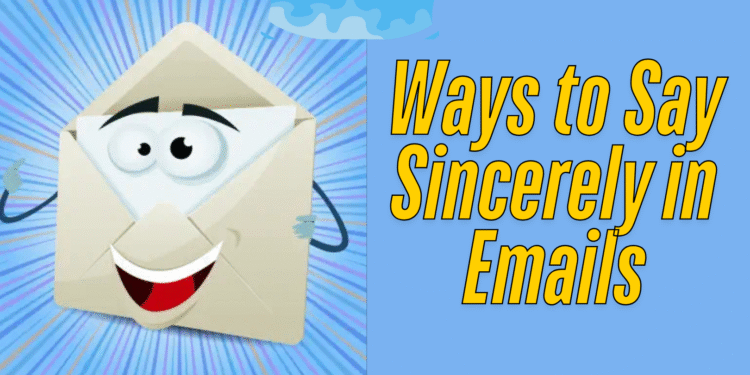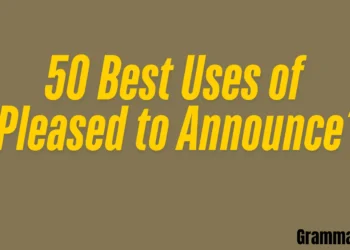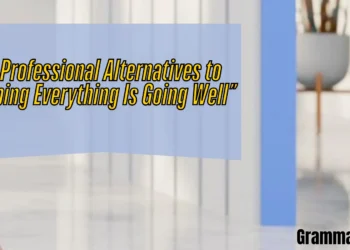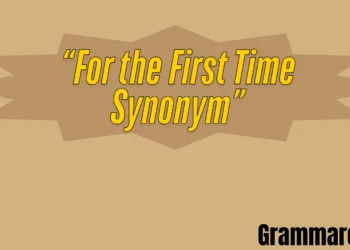Just like the main message of an email, letters, or other forms of communication, the closing should also be accurate. Kind and thoughtful ways of expressing oneself in writing can create an impact that lasts for generations. Although “sincerely” done is a polite sign-off, there’s a multitude of other options that can either give a personal touch or better express your character. Whichever way you prefer, casual or formal, these options will provide you with the ability to express warmth and real clarity while closing your message.
What does“Sincerely” mean?
In written correspondence, such as letters and emails, the word “Sincerely” is sometimes used as a formal concluding note. It shows honesty, respect, and real purpose. The sender signals their letter is honest and respectfully sent by signing off “Sincerely.” It offers a courteous and expert means to end correspondence. It appears most frequently in official and business papers.
Is it professional/polite to say “Sincerely”?
Yes, “sincerely” is both courteous and businesslike. Job applications, corporate proposals, legal letters, and other formal contexts across sectors all value it. It shows respect for the receiver and politeness. Because of its classic character, it offers a secure and dependable option in corporate communication. It could, though, seem too inflexible in everyday chats.
Advantages and Disadvantages of using sincerely
Advantages of Using “Sincerely”
Universally Accepted: It is a well-known and generally accepted closing, particularly in formal and professional communication.
Professional Tone: “Sincerely” communicates respect, seriousness, and professionalism—perfect for official documents, cover letters, and formal emails.
Neutral and Non-Offensive: It is safe for sensitive topics or unknown receivers because it lacks emotional depth.
Transmit Integrity: The word itself implies genuine intent, indicating that the content of your message is honest and trustworthy.
Clear and simple: It wraps the correspondence simply and is a simple closing that doesn’t divert attention from the message.
Disadvantages of using “Sincerely”
Lacks Warmth: Personal or emotional communications make it sound frigid or aloof.
Feels antiquated in specific settings: “Sincerely” might be too formal or old-fashioned in informal or contemporary digital communication.
Not intimate: It makes less sense to develop rapport because it doesn’t show much personality or emotion.
Overused: If used in every message, it may seem impersonal or generic because of its ubiquity.
May not fit every audience: It might be too rigid for younger audiences or relaxed contexts; they would instead choose closings like “Best,” “Thanks,” or “Take care.”
When to Use “Sincerely”
“Best wishes” is most appropriate for informal and semi-formal settings. This includes job application letters, business letters, professional email correspondence, or first introductions. It works for messages that contain formal business with the other party, solicit business, or during formal business appreciation notes. It would be ok to use this phrase since it is better than so many other alternatives. “Best wishes” is awkward and neutral if you don’t know the person’s feelings towards you.
What tone does it carry, “Sincerely”?
Formally, respectfully, and neutral, the tone of “Sincerely” conveys honesty and simplicity without being emotional or too friendly. While maintaining professionalism, it does not provide personal warmth. Its elegance and openness make it appropriate for polite or serious interaction. It helps one to project a refined and mature image.
When to avoid using “Sincerely”?
“Sincerely” should be avoided. For personal or friendly correspondence that is casual in tone and demands easygoing words, “sincerely” will not work as the sign-off. A close friend or a colleague will find it strange along with people who are well-known to you or in writing with a little creativity. The use of phrases such as “Best” or “Warm regards” or Cheers” captures the essence of such situations.
Professional alternatives of “Sincerely”

1. Top Regards
Meaning: Professionally wishing someone well.
Definition: Frequently used in corporate emails, a courteous sign-off.
Explanation: Most workplace communication strikes a good mix of warmth and formality.
Example: Many thanks for your help– Best wishes, Alex
Best uses: Corporate emails, first-time outreach, or overall follow-up
Worst Use: Strong emotional or romantic communications.
Tone: Polite, professional, relatively warm.
2. Heartfelt greetings
Meaning: A kind and respectful farewell.
Definition: A mellower, more amicable variation of “Best wishes.”
Explanation: Adds a soft tone yet remains professional. Perfect for sensitive workplace communication.
Example: Looking forward to your response, for instance. Warm greetings, Sarah
Best Uses: courteous follow-ups, human resources messages, or customer interactions.
Worst Use: Between near friends, super casual messages.
Tone: polite, friendly, reverent.
3. Greetings from warm regards
Meaning: A more amicable variation of a formal farewell.
Definition: In professional or semiformal contexts, a little more heartfelt signoff.
Explanation: Add emotional warmth without sacrificing professionalism
Example: Thanks once more for your help. Warm greetings, Jason
Best Use: When you connect with coworkers or clients.
Worst Use: legal or very formal paperwork.
Tone: Warm, thoughtful, semiformal.
4. Regarding
Meaning: A general, courteous closing.
Definition: An unbiased means of showing respect or recognition.
Explanation: Less famous than “Best regards,” but still appropriate in official emails.
Example: Hoping for our meeting. Respectfully, Maya
Best Use: Internal emails or non-sensitive workplace issues.
Worst Use: Emotional or personal letters.
Tone: formal, simple, neutral.
5. With Reverence
Meaning: Politeness or deference
Definition: A formal sign-off showing great respect.
Explanation: Usually used when treating high authorities or conveying difficult news in politeness.
Example: I found the suggestion. Respectfully, James
Best Use: while disagreeing or composing to influential people.
Worst Use: Casual or friend notes.
Tone: Formal, respectful, serious.
6. Yours truly
Meaning: A classic, courteous farewell.
Definition: A traditional farewell expressing respect and honesty.
Explanation: Used primarily in American English; regarded as a bit formal but welcoming.
Example: I anticipate your response soon. Yours truly, Amanda
Best Use: Formal business emails, and cover letters.
Worst Use: Informal conversation or creative writing.
Tone: Genuine, courteous, traditional.
7. Yours faithfully
Meaning: Yours with loyalty and respect.
Definition: A conventional British English sign-off used when the receiver’s name is unknown.
Explanation: Suitable for letters beginning with “Dear Sir/Madam.”
Example: Thank you for your attention. Sincerely, Peter Roberts
Best Use: Formal business correspondence or legal records.
Worst Use: Personal correspondence or emails.
Tone: Very formal, courteous.
8. Kindly
Meaning: gently and respectfully.
Definition: A formal farewell that displays grace and courtesy.
Explanation: Less prevalent yet elegant and diplomatic sound.
Example: I want us to be able to settle this issue right soon. Kind regards, Megan
Best Use: Official invitations or diplomatic communication.
Worst Use: Informal office or casual communication.
Tone: sophisticated, formal, elegant.
9. Yours respectfully
Meaning: Concluding with great respect.
Definition: A polite and humble exit.
Explanation: Good for formal requests or hard senior messages.
Example: I value your consideration and time. Yours faithfully, Ahmed
Best Use: Letters to authorities, teachers, or official applications.
Worst Use: Friendly talks or family letters.
Tone: formal, humble, reverent.
10. Yours very truly
Meaning: With honest intentions and respect.
Definition: This is a typical sign-off when the recipient’s name is known.
Explanation: In both the U.S. and the U.K., formal writing is notably used for job applications.
Example: I appreciate your giving my application some consideration. With best regards, Emily Carter
Best Uses: Job emails, formal requests, cover letters.
Worst Use: Casual or emotive personal messages.
Tone: Sincere, respectful, formal.
11. About Respect
Meaning: A signoff showing respect and caring.
Definition: Shows with grace and respect that the message is distributed.
Explanation: Frequently employed in formal disagreements or opinion-based interactions.
Example: Though I disagree on the topic, I cherish your opinion. Respectfully, Jordan
Best Use: Academic debates, professional disputes, and disagreements.
Worst Use: Casual or funny notes.
Tone: formal, professional, quiet.
12. Respectfully
Meaning: Appreciative gratefulness.
Definition: A signoff conveying respect and thankfulness.
Explanation: Adds a thank you note to the conclusion of an official correspondence.
Example: Thanks for your quick reply. Dr. Khan, with gratitude.
Best Use: client emails, polite replies, acknowledgments.
Worst Use: disciplinary or correctional notes.
Tone: Thankful, warm, courteous.
13. In Admiration
Meaning: Acknowledgement and thanks
Definition: A closing stressing thankfulness and recognition is defined here.
Explanation: Frequently employed in follow-up or thank-you notes.
Example: Your support is quite valuable to us. Michelle, with great gratitude
Best uses: include donor outreach, client thank-yous, and mentor letters.
Worst Use: Daily company updates.
Tone: Grateful, formal, welcoming.
14. With Thanks
Meaning: Finished with sincere thanks.
Definition: A heartfelt goodbye meant to show great thanks.
Explanation: More passionate and intense than “with appreciation.”
Example: Your compassion will not be overlooked. Sofia, in thankfulness
Best Uses: Letters of thankfulness, personal appreciation, and genuine acts.
Worst Use: Formal business letters.
Tone: Emotional, warm, honest.
15. With best wishes
Meaning: Wishing the receiver well.
Definition: An amicable yet formal approach to concluding a communication.
Explanation: Politeness meets a pleasant, upbeat attitude here.
Example: I hope the project goes well. Best wishes, Daniel
Best Use: Well-wishing emails, colleague goodbyes, and retiring notes.
Worst Use: Highly legal or technical correspondence.
Tone: warm, courteous, hopeful.
16. Yours in service
Meaning: Showing devotion and commitment.
Definition: Shows a desire to help and support the recipient.
Explanation: Used generally in leadership situations in communities or customer service.
Example: We are always here to assist. Yours in service, Customer Care Team
Best Use: Includes nonprofit areas, customer service, and community outreach.
Worst Use: Financial communication is among the most egregious uses.
Tone: Committed, respectful, encouraging.
17. Sincerely Yours
Meaning: Exhibiting great respect and consideration.
Definition: A formal variation of “Respectfully” that adds a personal touch.
Explanation: Shows great regard in official letters.
Example: I appreciate your leadership and time. Respectfully yours, Thomas
Best Uses: Letters to authorities, appeals, job applications.
Worst Use: Friendly chatter or informal emails
Tone: Polished, formal, deferential.
18. Best Wishes
Meaning: A very considerate farewell.
Definition: A warm and somewhat more personal variation of “Warm greetings.”
Explanation: Ideal when you want to show actual warmth while keeping professional.
Example: Working with you has been a delight. Nina, warmest regards
Best Usage: Close customer relationships, considerate, courteous notes.
Worst Use: A Bad Use is a cold or conflict-heavy letter.
Tone: Kind, open, semiformal.
19. Truly yours
Meaning: A closure stressing honesty and true intentions.
Definition: A customized “Yours sincerely” variant with a heightened emotional tone.
Explanation: It sounds considerate and sincere and is a fit for significant messages.
Example: Your leadership motivates me, for instance. Yours in sincerity, Rebecca
Best usage: Mentorship, sincere notes, and significant messages.
Worst Uses: Mass communication or general company updates.
Tone: truthful, kind, respectful.
20. Gratefully
Meaning: Appreciation and thanks for help.
Definition: A brief, classy way to show gratitude at the end of a letter.
Explanation: Excellent for professional thank-you notes or recognition.
Example: Thank you for your fast response. Respectfully, Mark
Best Uses: Client appreciation, sincere answers, thank you emails.
Worst Use: close personal or emotive communications.
Tone: Grateful, exquisite, semiformal.
21. Best
Meaning: A brief and pleasant farewell, wishing someone good fortune.
Definition: Lighthearted, casual abbreviation of “Best regards.”
Explanation: Perfect for quick, courteous, and professional emails where you want to remain approachable.
Example: Tell me if you need anything else. Best, Jamie
Best Use: Daily professional emails, internal team communications.
Worst Use: Legal paperwork or formal business correspondence.
Tone: Friendly, casual professional, neutral.
22. All the best
Meaning: Wishing someone well in everything they do.
Definition: Suitable for both personal and business communications, a warm and kind farewell.
Explanation: It’s more personable than “Best,” typically used when leaving or showing support.
Example: Best of luck with your next job! Rachel, all the best.
Best Use: Well wishes, farewell notes, casual corporate emails.
Worst Use: Formal or disciplinary letters only.
Tone: warm, encouraging, positive.
23. Greetings
Meaning: A cheerful, friendly farewell.
Definition: also indicating “thanks,” a laidback closure frequently used in British and Australian English.
Explanation: Perfect for laid-back talks or amicable work partnerships.
Example: Eager for next week’s catch-up. Cheers, Alex
Best Use: Casual emails with co-workers or peers.
Worst Uses: Formal business proposals or serious matters.
Tone: Lively, informal, light.
24. Thanks again
Meaning: In your closing, you reiterate thanks.
Definition: Emphasizing ongoing gratitude, a follow-up thank you.
Explanation: Exhibits good manners and strengthens your gratitude.
Example: I am grateful for your help on the project. Thanks once more, Carla
Best Use: professional communications emphasizing follow-up or gratitude.
Worst Uses: Cold or conflict-resolution emails.
Tone: Appreciative, polite, kind.
25. Appreciate
Meaning: A basic yet honest thank you.
Definition: Direct recognition of the recipient’s effort, time, or contribution.
Explanation: Perfect for nearly every circumstance, polished yet genuine.
Example: Appreciate your input. Many thanks, Omar
Best Use: Workplace messages and emails with thanks.
Worst Use: In highly emotional or creative situations necessitating more flair.
Tone: courteous, grateful, businesslike.
26. Many Thanks
Meaning: A warmer and more enthusiastic version of “Thank You.”
Definition: Closing gently and expressively with thanks.
Explanation: Gives a kind and respectful attitude without sounding overly official.
Example: I liked our meeting. Many thanks, Priya
Best Uses: Client emails, confirmations, joint interactions.
Worst Use: The most bad Use is legal or stiff documents.
Tone: Appreciative, courteous, relatively warm.
27. Regards and thanks.
Meaning: Appreciate coupled with courteous closure.
Definition: A hybrid signoff that is effective and polite.
Explanation: Particularly in South Asian corporate contexts, business emails often include these phrases.
Example: Please locate the attached file. Many thanks and kind greetings, Naveed
Best Use: Business updates, customer interaction.
Worst Use: Highly emotional or casual friend emails.
Tone: professional, respectful, pragmatic.
28. In Appreciation
Meaning: Concluding with thanks.
Definition: An elegant and professional way to express thanks.
Explanation: Add poise and class to messages containing requests or follow-ups.
Example: I am grateful for your time and assistance. Gratitude Elise
Best Use: Business benefits, formal yet grateful emails.
Worst Uses: comedic or chatty notes.
Tone: Formal, honest, classy.
29. Much appreciated
Meaning: Heartfelt gratitude for aid or help.
Definition: A more chat-like way of showing great appreciation.
Explanation: Casual but respectful; ideal for quickly and gently expressing thanks to someone.
Example: Many thanks for reversing that so quickly. Leo, many thanks.
Best. Use: Quick responses and internal team communication.
Worst Use: legal, cold, or high-stakes communications.
Tone: Relaxed, friendly, appreciative.
30. Grateful
Meaning: Much appreciation and thanks.
Definition: A polished, honest, and occasionally emotional sign-off.
Explanation: Usually employed when the author truly appreciates assistance or empathy.
Example: Your ongoing direction makes me grateful. Gratefully, Anna
Best Use: Thank notes, favors, mentoring letters
Worst Use: Everyday corporate communication.
Tone: sincere, respectful, welcoming.
31. Keep well
Meaning: Hoping for the recipient’s health and well-being.
Definition: A warm and human-centric closing that highlights concern.
Explanation: Particularly significant during times of sickness or doubt.
Example: Tell me if you require anything further. Stay well, Brian
Best Use: personal check-ins, post-pandemic context, health-conscious messaging.
Worst Use: Highly technical or critical communication.
Tone: Caring, warm, compassionate.
32. Anticipated
Meaning: Anticipating something upcoming.
Definition: An optimistic conclusion establishing a tone for the future.
Explanation: Good to show excitement for upcoming steps or ongoing interaction.
Example: Eager for your reply. In the future, Hannah
Best Uses: scheduling, follow-up emails, or group projects.
Worst Use: Unrelated ends or conflict resolution.
Tone: Optimistic, encouraging, forward-looking.
33. Look after
Meaning: Wishing someone individual wellness.
Definition: Used personally and professionally, a soft, loving farewell.
Explanation: Show you value the person beyond the message.
Example: Thank you once again for your support. Lily, take care.
Best Use: Warm sign-offs for coworkers, friendly clients, or acquaintances.
Worst Use: Highly formal papers.
Tone: Gentle, warm.
34. Every best wish
Meaning: Offering lovely wishes in an official or semi-formal manner.
Definition: An understatement, sincere manner to wrap up a message.
Explanation: When communicating best results or well-being.
Example: I wish the function goes well. Daniel, best wishes always.
Best Use: farewells, congratulations, well wishes, notes.
Worst Use: review of performance or escalated issues.
Tone: Kind, courteous, somewhat formal.
35. To your ongoing success
Meaning: Wishing for continuous success and advancement.
Definition: Encouragement and uplifting motivational sign-off.
Explanation: Suitable when acknowledging someone’s achievements or expected development.
Example: Your quarter was superb. Tanya, for your ongoing success
Best Uses: promotions, career appreciation, networking.
Worst Use: overall grievances or updates.
Tone: inspiring, uplifting, positive.
36. Wanting you well
Meaning: Sincere expectations for significant events
Definition: A tranquil and sympathetic remark to finish on a nice note.
Explanation: Works perfectly in empathetic conversation or during transitional situations.
Example: Take your time responding with examples. Best wishes, Chris.
Best Use: Supportive messages, change of job or life phase.
Worst Use: Stricter corporate updates or legal documents.
Tone: compassionate, empathetic, warm.
37. Take care.
Meaning: A brief, lovely statement implying individual care.
Definition: A laid-back but courteous approach to expressing worry or empathy.
Explanation: Often employed when you are concerned about someone’s condition.
Example: Appreciating your follow-up on that. Have a good Mark
Best Use: Friendly emails, health-related messages, well-considered closings.
Worst Use: Unfamiliar or formal correspondence.
Tone: kind, individual, soft.
38. Appreciate your time.
Meaning: Appreciation for someone’s effort or attention.
Definition: A sincere acknowledgment of their time is appreciated.
Explanation: Particularly useful in interviews, meetings, or requests.
Example: Talking with me takes time; I understand it. Thanks for your time, John.
Best Uses: Time-sensitive problems, client meetings, employment applications.
Worst Use: simple communications or casual conversations.
Tone: Respectful, grateful, courteous.
39. Best of luck.
Meaning: Provide hope for favorable results.
Definition: An inspirational closing that supports forward thinking.
Explanation: Excellent for congratulating or inspiring achievement.
Example: I trust in your skills, Olivia, best of luck.
Best uses: congratulatory messages, support notes, mentorship emails.
Worst Use: Transactional or neutral updates.
Tone: respectful, supportive, encouraging.
40. Till next time
Meaning: Expecting the following engagement.
Definition: A cordial approach to parting without finality.
Explanation: Suggests future meetings or continuous communication.
Example: Lena, that was an excellent talk. See you next time.
Best Use: personal updates, casual networking.
Worst Use: formal one-off messages or complaint replies.
Tone: friendly, light, forward-looking.
41. Catch you later
Meaning: Catch you soon.
Definition: A casual, light-hearted means of parting.
Explanation: Perfect for friends, coworkers, or informal office settings.
Example: I’ll send over the doc tonight. I’ll catch you later, Drew!
Best Use: informal workplaces and peer-to-peer conversations.
Worst usage: formal or outward correspondence.
Tone: relaxed, easygoing, happy.
FAQs
1. Can professional emails use “Sincerely”?
Yes, formal and professional emails often use the word “Sincerely.” Respect, sincerity, and gravity are conveyed; it fits business letters, job applications, and official correspondence.
2. May I use it truly in everyday conversation?
Though technically correct, it can seem too formal or inflexible in daily contexts. Closures like “Best,” “Take care,” or “Cheers” often feel more natural in informal or friendly emails.
3. Are your actual and sincere differences?
Often abbreviated as Sincerely in American English. In British English, yours truly is generally used after a greeting when the recipient’s name is familiar (e.g., Dear Mr. Khan).
4. Under what conditions should I refrain from using Sincerely?
Keep it at arm’s length if the message is emotional, light, or fun. Utilizing sincerity in personal, funny, or artistic emails may seem improper or too official.
Conclusion
A traditional professional sign-off is sincere, respectful, and professional. It is best for formal emails, job applications, and polite communication. Though its rigidity or oldness might seem somewhat odd in some more casual settings, its transparency and worldwide acceptance make it a secure and reliable choice for serious or polite correspondence. Knowing when to use or replace it will improve your effectiveness and your communication tone.








